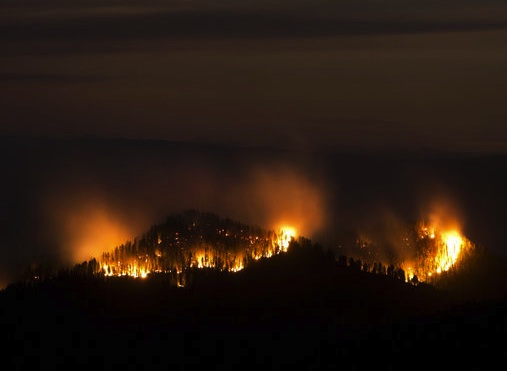
Jackson Hole Daily, Mike Koshmrl- Temperatures are markedly cooler and rain showers have been passing over northwest Wyoming, but along with the friendly weather for firefighting has come lightning strikes that have set new areas ablaze.
On Sunday and Monday in Grand Teton National Park alone, four new fires were reported and suppressed after being sparked by bolts of electricity that shot out of overhead thunderclouds. With activity on the 23-square-mile Berry Fire reduced, managers were able to peel off some of their resources and send firefighters to battle elsewhere.
“The moisture has definitely significantly moderated fire behavior,” Berry Fire spokeswoman Jesse Bender said. “One of the things that it’s allowed us to do is support the new fires that have started in the park and in the forest. We’ve been able to provide some assistance to the new starts.”
Sparked west of the Potholes in a visible area was the 1.5-acre Burned Ridge Fire, which was burning actively and spotting into timber stands before two water-dropping helicopters, a rappel crew and a 20-person hand crew arrived to surround and suppress the blaze.
Also Sunday, another 20-person crew was dispatched to cut saw line around the Lozier Hill Fire, which was burning on an acre of heavy, downed logs left behind from the 1998 Emma Matilda Fire, according to a park statement. Colter Bay’s Engine 4 suppressed the Pilgrim Meadows Fire near Pilgrim Creek on Sunday, and the crew was able to stomp out the tenth-acre fire where it burned near Highway 89/191/287.
Then, on Monday, crews worked to suppress another lightning-started wildfire along the Snake River bottom, information officer Traci Weaver said.
With still-dry fuels and lots of wildfire activity in the area, park officials didn’t take any chances by allowing the wildfires to burn for the benefit of the landscape, Grand Teton’s Deputy Fire Management Officer Mack McFarland said in a statement.
“Both the Burned Ridge and Lozier fires are burning in areas in which we would like fire to play its natural role,” McFarland said, “but given the current high fire danger and limited available resources, we made the decision to suppress both fires.”
Progress on the Berry Fire, meanwhile, allowed fire managers Monday to scale back the intensity of the firefight in northern Grand Teton park and in the nearby Bridger-Teton National Forest. Some 225 personnel were still assigned to the fire on Labor Day.
“The type 2 team is transitioning down to a type 3 level,” Bender said, “due to the fact that we’ve successfully accomplished our goals and due to the fact that the fire activity is so reduced.”
A large area closure is still in effect from the Berry Fire, which has burned 13,028 acres of parkland and 1,513 acres in the forest, including in parts of the 1988 Huck Fire scar. Grassy Lake Road cannot be accessed from the park, and while the convenience store and gas station at Flagg Ranch are open, overnight lodging remains closed.
The weather that moved over northern Jackson Hole also extended into Yellowstone National Park.
More than 200 lightning strikes were recorded in eastern Yellowstone, officials reported, resulting in at least two new fire starts near Tower Junction: one near the Petrified Tree and another at Specimen Ridge.
At least four large wildfires are still actively burning in Yellowstone as well, including the 63-square-mile Maple Fire, which continues to grow slowly north of the entrance road past West Yellowstone, Mont.
Although temperatures will be relatively cool compared with last week, fire weather forecasters are anticipating a gradual warming and drying trend with minimal precipitation in the days ahead.
